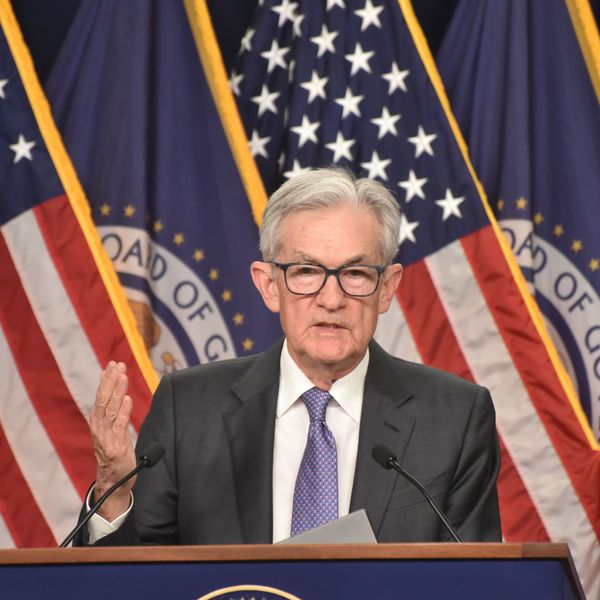
Traders work after the opening bell at the New York Stock Exchange on August 5, 2019 in New York City. (Photo: Johannes Eisle/AFP/Getty Images)
As Household Debt Hits $14 Trillion, Economists Say Fed Quantitative Easing Solution for Next Recession Insufficient
"For most people, these policies will further increase in their cost of living, while their wages remain stagnant."
On the heels of reports that U.S. household debt hit $14 trillion for the first time in history, Federal Reserve Chair Jerome Powell told lawmakers Wednesday that the central bank would use quantitative easing as the primary weapon to combat the next recession.
With interest rates hovering around 1.50% and 1.74%, quantitative easing--injecting more cash into the economy through buying back government bonds--is the best solution available, said Powell.
"We will have less room to cut [rates,]" Powell told the Senate Banking Committee. "That means it is much more likely that we will have to turn to the tools that we used in the financial crisis when we hit the lower bound."
As Market Watch reported:
In testimony before the Senate Banking Committee, Powell said the Fed had two recession-fighting tools; buying government bonds, known as QE, and communicating clearly with markets about interest-rate policy, routinely considered as "forward guidance."
"We will use those tools--I believe we will use them aggressively should the need arise to do so," Powell said.
Left economist Arash Kolahi took to Twitter to push back against the strategy, calling the tactic "basically upward wealth redistribution at the expense of the many."
"For most people, these policies will further increase in their cost of living, while their wages remain stagnant," Kolahi explained. "In effect, it's like taxing the many to further enrich the investor class."
Powell's testimony came a day after Bloomberg reported U.S. household debt topped $14 trillion in the last quarter, rising $601 billion in 2019.
According to Bloomberg, delinquencies have risen alongside total debt--a worrying sign for the future. Five percent of auto loans are delinquent and credit card delinquencies increased in 2019 to 8.36%.
Student debt, a major source of worry for young people, grew as well:
Among student debt, one in nine borrowers were 90+ days delinquent or in default in 2019, and this figure may be understated. About half of student loans are currently in deferment, in grace periods or in forbearance and therefore temporarily not in the repayment cycle. Once these loans enter that cycle, delinquency rates are projected to be roughly twice as high, according to the Fed report.
Economic observers fear that with the rise in quantitative easing, stocks are being overvalued and that the Federal Reserve is blocking the market from course correcting, possibly setting up a crash when the cash flow stops.
"The risk is what happens when the Fed stops increasing their balance sheet," Peter Boockvar, chief investment officer with Bleakley Advisory Group, told Reuters in January. "What will stocks do when that liquidity spigot stops? We'll have to see."
An Urgent Message From Our Co-Founder
Dear Common Dreams reader, The U.S. is on a fast track to authoritarianism like nothing I've ever seen. Meanwhile, corporate news outlets are utterly capitulating to Trump, twisting their coverage to avoid drawing his ire while lining up to stuff cash in his pockets. That's why I believe that Common Dreams is doing the best and most consequential reporting that we've ever done. Our small but mighty team is a progressive reporting powerhouse, covering the news every day that the corporate media never will. Our mission has always been simple: To inform. To inspire. And to ignite change for the common good. Now here's the key piece that I want all our readers to understand: None of this would be possible without your financial support. That's not just some fundraising cliche. It's the absolute and literal truth. We don't accept corporate advertising and never will. We don't have a paywall because we don't think people should be blocked from critical news based on their ability to pay. Everything we do is funded by the donations of readers like you. Will you donate now to help power the nonprofit, independent reporting of Common Dreams? Thank you for being a vital member of our community. Together, we can keep independent journalism alive when it’s needed most. - Craig Brown, Co-founder |
On the heels of reports that U.S. household debt hit $14 trillion for the first time in history, Federal Reserve Chair Jerome Powell told lawmakers Wednesday that the central bank would use quantitative easing as the primary weapon to combat the next recession.
With interest rates hovering around 1.50% and 1.74%, quantitative easing--injecting more cash into the economy through buying back government bonds--is the best solution available, said Powell.
"We will have less room to cut [rates,]" Powell told the Senate Banking Committee. "That means it is much more likely that we will have to turn to the tools that we used in the financial crisis when we hit the lower bound."
As Market Watch reported:
In testimony before the Senate Banking Committee, Powell said the Fed had two recession-fighting tools; buying government bonds, known as QE, and communicating clearly with markets about interest-rate policy, routinely considered as "forward guidance."
"We will use those tools--I believe we will use them aggressively should the need arise to do so," Powell said.
Left economist Arash Kolahi took to Twitter to push back against the strategy, calling the tactic "basically upward wealth redistribution at the expense of the many."
"For most people, these policies will further increase in their cost of living, while their wages remain stagnant," Kolahi explained. "In effect, it's like taxing the many to further enrich the investor class."
Powell's testimony came a day after Bloomberg reported U.S. household debt topped $14 trillion in the last quarter, rising $601 billion in 2019.
According to Bloomberg, delinquencies have risen alongside total debt--a worrying sign for the future. Five percent of auto loans are delinquent and credit card delinquencies increased in 2019 to 8.36%.
Student debt, a major source of worry for young people, grew as well:
Among student debt, one in nine borrowers were 90+ days delinquent or in default in 2019, and this figure may be understated. About half of student loans are currently in deferment, in grace periods or in forbearance and therefore temporarily not in the repayment cycle. Once these loans enter that cycle, delinquency rates are projected to be roughly twice as high, according to the Fed report.
Economic observers fear that with the rise in quantitative easing, stocks are being overvalued and that the Federal Reserve is blocking the market from course correcting, possibly setting up a crash when the cash flow stops.
"The risk is what happens when the Fed stops increasing their balance sheet," Peter Boockvar, chief investment officer with Bleakley Advisory Group, told Reuters in January. "What will stocks do when that liquidity spigot stops? We'll have to see."
On the heels of reports that U.S. household debt hit $14 trillion for the first time in history, Federal Reserve Chair Jerome Powell told lawmakers Wednesday that the central bank would use quantitative easing as the primary weapon to combat the next recession.
With interest rates hovering around 1.50% and 1.74%, quantitative easing--injecting more cash into the economy through buying back government bonds--is the best solution available, said Powell.
"We will have less room to cut [rates,]" Powell told the Senate Banking Committee. "That means it is much more likely that we will have to turn to the tools that we used in the financial crisis when we hit the lower bound."
As Market Watch reported:
In testimony before the Senate Banking Committee, Powell said the Fed had two recession-fighting tools; buying government bonds, known as QE, and communicating clearly with markets about interest-rate policy, routinely considered as "forward guidance."
"We will use those tools--I believe we will use them aggressively should the need arise to do so," Powell said.
Left economist Arash Kolahi took to Twitter to push back against the strategy, calling the tactic "basically upward wealth redistribution at the expense of the many."
"For most people, these policies will further increase in their cost of living, while their wages remain stagnant," Kolahi explained. "In effect, it's like taxing the many to further enrich the investor class."
Powell's testimony came a day after Bloomberg reported U.S. household debt topped $14 trillion in the last quarter, rising $601 billion in 2019.
According to Bloomberg, delinquencies have risen alongside total debt--a worrying sign for the future. Five percent of auto loans are delinquent and credit card delinquencies increased in 2019 to 8.36%.
Student debt, a major source of worry for young people, grew as well:
Among student debt, one in nine borrowers were 90+ days delinquent or in default in 2019, and this figure may be understated. About half of student loans are currently in deferment, in grace periods or in forbearance and therefore temporarily not in the repayment cycle. Once these loans enter that cycle, delinquency rates are projected to be roughly twice as high, according to the Fed report.
Economic observers fear that with the rise in quantitative easing, stocks are being overvalued and that the Federal Reserve is blocking the market from course correcting, possibly setting up a crash when the cash flow stops.
"The risk is what happens when the Fed stops increasing their balance sheet," Peter Boockvar, chief investment officer with Bleakley Advisory Group, told Reuters in January. "What will stocks do when that liquidity spigot stops? We'll have to see."

